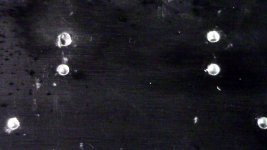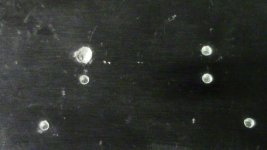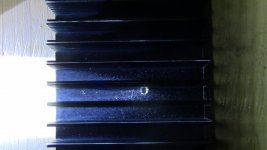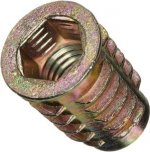Another v1.4 upgrade takes place today, customer requested Naim's approach with 2 mm Al-Oxide thermalloy insulators. Now 2 mm extra distance means serious drop of capacitance to chassis. We'll hear the results over the weekend.
Offers started today, expect an e-mail.
Are these insulators ok to use?They are 3mm thick.
AOS 218 247, Aluminium oxide wafers, Heatsinks f.cool, Fischer Elektronik
As announced in below's post, some preliminary pics of Black Monolith rising, just a teaser for the moment.
Hi LC, can I please ask what will be the final size of the monolith monoblock chassis? I would really like a compact unit if possible.
One other question - with my current DAC/pre-amp, I obviously have to switch on my current amp after the DAC and turn off before the DAC to avoind speaker thumps. This get a bit difficult for my wife/kids to remember. Is there any way for me to do this automatically? I think the SMPS allows this, but not sure how to wire it up.
Monolith dimensions are 180 x 180 x 100 mm (W x H x D) without pads, for which I still have to figure out most suitable ones, but surely there will be only three.
No matter what kind of DAC/preamp you own, whether DIY or production one, the issue has to be solved inside the unit. Use relay contacts to shorten output to GND after power is switched off and delayed release few seconds after startup.
No matter what kind of DAC/preamp you own, whether DIY or production one, the issue has to be solved inside the unit. Use relay contacts to shorten output to GND after power is switched off and delayed release few seconds after startup.
mbrennwa,
I think you would have to quadruple the cost of the units if LC had gone in that direction of certification. I don't think you could certify the units in isolation as they are being delivered, it would need to be a complete unit, not a component of a complete amplifier. I'll let LC make his own statement but it seems absurd to expect CE or UL listing on a diy product like an amplifier module.
I think you would have to quadruple the cost of the units if LC had gone in that direction of certification. I don't think you could certify the units in isolation as they are being delivered, it would need to be a complete unit, not a component of a complete amplifier. I'll let LC make his own statement but it seems absurd to expect CE or UL listing on a diy product like an amplifier module.
mbrennwa,
I think you would have to quadruple the cost of the units if LC had gone in that direction of certification. I don't think you could certify the units in isolation as they are being delivered, it would need to be a complete unit, not a component of a complete amplifier. I'll let LC make his own statement but it seems absurd to expect CE or UL listing on a diy product like an amplifier module.
If I want to build a safe amplifier and have my *** covered, it would help to use modules that are CE compliant (or UL or whatever, I don't know the details). Many modules or parts do have a CE label. For example, take a careful look here and you'll spot a number of CE labels on the photos. In fact, there are clear rules (laws?) about which products need CE certification, and it does not matter how a customer uses the product (e.g., for DIY or something else). But I am not a lawyer and I might be wrong.
Mb,
Just because you can see some individual CE labeled components does not mean the entire assembly is CE certified. Individual components often have those certs but the unit has not passed a lab test. LZ can't control the power supply you use nor the build quality of the final units, you could use a poor quality ps or even not hook up a ground connection to the ps and all bet would be off. CE and UL type of testing is very expensive and for something like an amplifier would be the entire finished unit contained in an enclosure ready to use as far as I understand it.
Just because you can see some individual CE labeled components does not mean the entire assembly is CE certified. Individual components often have those certs but the unit has not passed a lab test. LZ can't control the power supply you use nor the build quality of the final units, you could use a poor quality ps or even not hook up a ground connection to the ps and all bet would be off. CE and UL type of testing is very expensive and for something like an amplifier would be the entire finished unit contained in an enclosure ready to use as far as I understand it.
CE compliant is only useful for a complete build, for an amplifier module it's worthless.
It's the implementation of all the parts (chassis, cabling, modules) that makes it CE compliant or not.
A good start is connecting the chassis to earth
It's the implementation of all the parts (chassis, cabling, modules) that makes it CE compliant or not.
A good start is connecting the chassis to earth
Last edited:
Hi Matthias
Would it be any easier to CE certified end product if each part would have CE for itself?
No matter the content, the unit would still need to be CE certified as a whole.
BTW nice speakers and tube amps you have on your web page. Maybe First One with tube pre-amp is what you need. Aurichal speakers would sound stellar with First One, trust me.
BR, L.C.
Would it be any easier to CE certified end product if each part would have CE for itself?
No matter the content, the unit would still need to be CE certified as a whole.
BTW nice speakers and tube amps you have on your web page. Maybe First One with tube pre-amp is what you need. Aurichal speakers would sound stellar with First One, trust me.
BR, L.C.

Is the FirstOne module certified by some kind of "safety label" like CE or similar?
Would it be any easier to CE certified end product if each part would have CE for itself?
No matter the content, the unit would still need to be CE certified as a whole.
I called up the Swiss authorities and aksed about this a while ago. They argued that if I'd just use certified modules, wire them up properly, the complete system should be fine in terms of safety regulations. I don't understand all the terms properly though.
BTW nice speakers and tube amps you have on your web page. Maybe First One with tube pre-amp is what you need. Aurichal speakers would sound stellar with First One, trust me.
Thanks for this
Cheers
Matthias
But I have also thought about the FirstOne 1.4 lately. Any chance I could compare my F5 with the FirstOne 1.4?
Cheers
Matthias
Nice trip to Switzerland would be a refreshing change.
Nice trip to Switzerland would be a refreshing change.
Anytime! Or would you consider borrowing a FO for a few days?
Enjoying the building process, then $SNAP@...
I have been plugging away bit by bit assembling this amp - mainly the chassis work.
I have a lot of pictures to post of the build, but I hit a massive discouraging road block today...
I had all the holes drilled in the heatsinks, and was almost done tapping the threads. I was down to my last round with the bottom tap, and it broke! Surprising, given it was a new Hanson Carbon tap. I will admit that I am new to using this stuff, but this I did not expect... I tried drilling, chipping it out, even going in from the other side, nope, not happening - it just got more embedded in the aluminum, and my hole got less useful. At this point, I see no choice but to save this heat sink for another project, and order a new one - and just drill and tap the holes all the way thru, forget this "bottom" tapping business, I guess I am out of my league on that one. I am lucky I got this far, plugging away with a good hand drill and extensive jigging. I do not have a drill press, CNC or anything like that. The sad thing about it, is one heat sink is completely done, and this one was down to the last turn on all the holes. I was so close...
Please excuse my creative crash here, this would be my attempt at crying out for some help...
Do any of You all see a way to salvage the heatsink, or should I order a new one? I thought about flipping the holes top to bottom, but that would leave the "bad" hole and the one across from it as "voids" for the mosfets.
I am going to sleep this on off...
I have been plugging away bit by bit assembling this amp - mainly the chassis work.
I have a lot of pictures to post of the build, but I hit a massive discouraging road block today...
I had all the holes drilled in the heatsinks, and was almost done tapping the threads. I was down to my last round with the bottom tap, and it broke! Surprising, given it was a new Hanson Carbon tap. I will admit that I am new to using this stuff, but this I did not expect... I tried drilling, chipping it out, even going in from the other side, nope, not happening - it just got more embedded in the aluminum, and my hole got less useful. At this point, I see no choice but to save this heat sink for another project, and order a new one - and just drill and tap the holes all the way thru, forget this "bottom" tapping business, I guess I am out of my league on that one. I am lucky I got this far, plugging away with a good hand drill and extensive jigging. I do not have a drill press, CNC or anything like that. The sad thing about it, is one heat sink is completely done, and this one was down to the last turn on all the holes. I was so close...
Please excuse my creative crash here, this would be my attempt at crying out for some help...
Do any of You all see a way to salvage the heatsink, or should I order a new one? I thought about flipping the holes top to bottom, but that would leave the "bad" hole and the one across from it as "voids" for the mosfets.
I am going to sleep this on off...

Attachments
- Home
- Vendor's Bazaar
- First One - mosFET amplifier module



